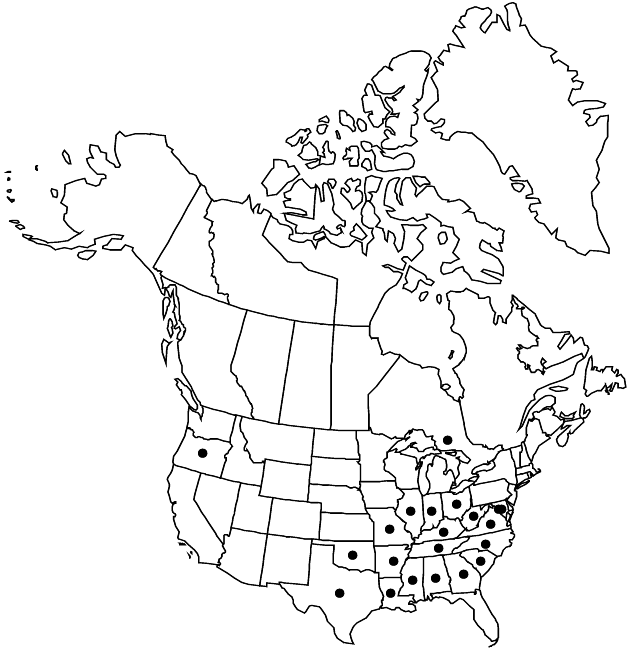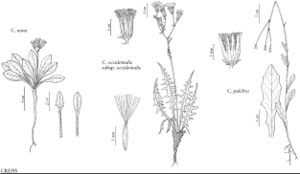Difference between revisions of "Crepis pulchra"
Sp. Pl. 2: 806. 1753.
imported>Volume Importer |
(Add missing state based on changes spreadsheet) |
||
| Line 30: | Line 30: | ||
|habitat=Dry open habitats, rolling grasslands, pastures, abandoned fields, waste areas, railroads, roadsides | |habitat=Dry open habitats, rolling grasslands, pastures, abandoned fields, waste areas, railroads, roadsides | ||
|elevation=0–3000 m | |elevation=0–3000 m | ||
| − | |distribution=Ont.;Ala.;Ark.;D.C.;Ga.;Ill.;Ind.;Ky.;La.;Md.;Miss.;Mo.;N.C.;Ohio;Okla.;Oreg.;S.C.;Tenn.;Tex.;Va.;W.Va.;Eurasia. | + | |distribution=Ont.;Ala.;Ark.;Calif.;D.C.;Ga.;Ill.;Ind.;Ky.;La.;Md.;Miss.;Mo.;N.C.;Ohio;Okla.;Oreg.;S.C.;Tenn.;Tex.;Va.;W.Va.;Eurasia. |
|introduced=true | |introduced=true | ||
|discussion=<p><i>Crepis pulchra</i> is identified by its annual habit; solitary, erect, glandular, and viscid stems; narrowly oblanceolate, runcinate, hispid leaves with relatively large terminal segments; glabrous and strongly keeled phyllaries; sometimes dimorphic cypselae; and fluffy, dusky white pappi.</p> | |discussion=<p><i>Crepis pulchra</i> is identified by its annual habit; solitary, erect, glandular, and viscid stems; narrowly oblanceolate, runcinate, hispid leaves with relatively large terminal segments; glabrous and strongly keeled phyllaries; sometimes dimorphic cypselae; and fluffy, dusky white pappi.</p> | ||
| Line 62: | Line 62: | ||
}}<!-- | }}<!-- | ||
| − | -->[[Category:Treatment]][[Category:Crepis]] | + | --> |
| + | [[Category:Treatment]] | ||
| + | [[Category:Crepis]] | ||
Revision as of 20:34, 6 January 2021
Annuals, 5–100 cm (taproots slender). Stems 1, erect, simple, proximally hispid and stipitate-glandular (viscid), distally glabrous. Leaves basal and cauline; petiolate; blades oblanceolate or runcinate, 1–24 × 1–5 cm, (bases attenuate) margins deeply pinnately lobed to denticulate (lobes triangular, terminal lobes largest), apices obtuse to acute, faces densely stipitate-glandular (viscid). Heads 10–40, in loose, corymbiform arrays. Calyculi of 5–7, ovate or lanceolate, glabrous bractlets 1–2 mm. Involucres cylindric (turbinate in fruit), 8–12 × 3–5 mm. Phyllaries 10–14, (green medially) lanceolate, 8–10 mm, (bases strongly keeled and thickened, margins scarious), apices acute, faces glabrous. Florets 15–30; corollas light yellow, 5–12 mm. Cypselae (monomorphic or dimorphic) green to yellowish brown, subcylindric, outer 5–6 mm, inner 4–5 mm, apices attenuate (not beaked), ribs 10–12; pappi dusky white (very fine, fluffy), 4–5 mm. 2n = 8.
Phenology: Flowering Apr–Aug.
Habitat: Dry open habitats, rolling grasslands, pastures, abandoned fields, waste areas, railroads, roadsides
Elevation: 0–3000 m
Distribution

Introduced; Ont., Ala., Ark., Calif., D.C., Ga., Ill., Ind., Ky., La., Md., Miss., Mo., N.C., Ohio, Okla., Oreg., S.C., Tenn., Tex., Va., W.Va., Eurasia.
Discussion
Crepis pulchra is identified by its annual habit; solitary, erect, glandular, and viscid stems; narrowly oblanceolate, runcinate, hispid leaves with relatively large terminal segments; glabrous and strongly keeled phyllaries; sometimes dimorphic cypselae; and fluffy, dusky white pappi.
Selected References
None.
